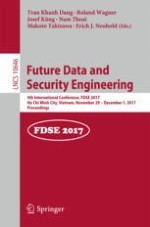2017 | Buch
Future Data and Security Engineering
4th International Conference, FDSE 2017, Ho Chi Minh City, Vietnam, November 29 – December 1, 2017, Proceedings
herausgegeben von: Tran Khanh Dang, Prof. Dr. Roland Wagner, Josef Küng, Nam Thoai, Makoto Takizawa, Erich J. Neuhold
Verlag: Springer International Publishing
Buchreihe : Lecture Notes in Computer Science
